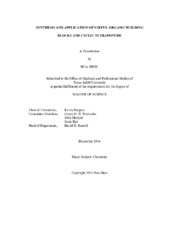| dc.description.abstract | Drug designing usually encounters two major difficulties: construction of small molecules and target finding for the molecules. This is frustrating because either one requires tremendous effort. My research focused on how well-known methods such as asymmetric hydrogenation and organocatalysis can facilitate organic synthesis and how EKO aided us to find protein targets for small molecules.
Synthesis of Z-allylic diols was a starting project. The beauty of trisubstituted allylic diols is that it can be converted to a lot of useful building blocks of organic molecules, such as 4,5-disubstituted furanone and 2,3-disubstituted furan. The construction of the scaffold needed an undervalued intermediate, vinylaluminate, which was developed decades ago. Treated with red-aluminum, 2-butyn-1-ol can be converted to a five-membered ring vinylaluminate intermediate. The only application of this intermediate was the conversion to vinyl iodide. We found a more valued application: reaction with aldehydes to form a Z-allylic diol scaffold.
The ideal was carried on further. Combination of two well-known methodologies, asymmetric hydrogenation and organocatalysis can result in the production of particularly high-value chirons. We prepared optically pure homo-Roche ester by asymmetric hydrogenation of a α,β-unsaturated ester. And chlorination, fluorination and amination of the ester product formed a series of useful chirons.
The two projects, though not directly related, but conceptually guided the third project: design and synthesis of small molecules that can disrupt protein-protein interactions, because we are eager to illustrate the merits of our novel approaches, EKO and EKOS. EKO is a computational program that can overlay small molecules over tens of thousands of protein-protein interfaces and find the best fit PPIs for the molecule. We used cyclic tetrapeptide and oxopiperazine dimers as examples to illustrate how EKO and EKOS work. And we also designed an expedient large-scale synthesis of cyclic tetrapeptide as probes to illustrate the idea that using creative computational methods for molecular design will have a large impact on contemporary life science. | en |


